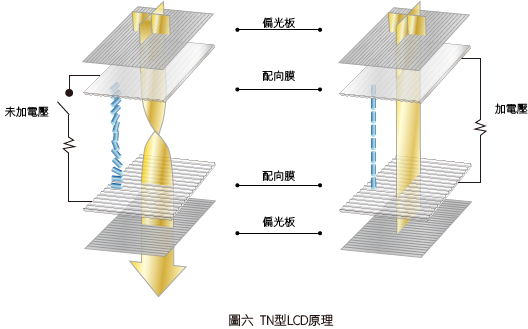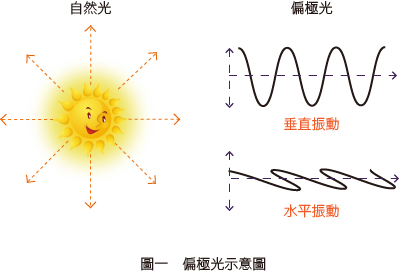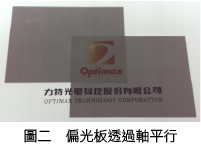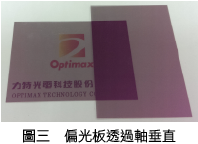The most commonly used polarizer is the linear polarizer. The structure is shown in Figure 4, including six layers of protective film, TAC (Tri-acetate cellulose), PVA (Polyvinyl alcohol), TAC, pressure-sensitive adhesive (PSA), and release film. structure。...More
The most commonly used polarizer is the linear polarizer. The structure is shown in Figure 4, including six layers of protective film, TAC (Tri-acetate cellulose), PVA (Polyvinyl alcohol), TAC, pressure-sensitive adhesive (PSA), and release film. structure. The protective film is used to protect the surface of the polarizer, and consumers need to tear it off when using it; TAC is used to protect PVA, so that PVA is not easy to be brittle, not easy to shrink, and prevents optics from being affected by moisture, and can provide different surface treatment functions; PVA is Manufacture the main body of polarized light; the lower TAC can be used to protect PVA or replace it with a compensation film with phase difference to compensate the liquid crystal; PSA is used to adhere to the glass substrate of LCD。
The most common polarizing plate nowadays is the H film invented by Edwin H. Land in 1938. The general process is shown in Figure 5. First, a film with polarizing properties is produced, and the hydrophilic PVA (Polyvinyl alcohol) After the film is soaked in water and swells,...More
The most common polarizing plate nowadays is the H film invented by Edwin H. Land in 1938. The general process is shown in Figure 5. First, a film with polarizing properties is produced, and the hydrophilic PVA (Polyvinyl alcohol) After the film is soaked and swelled, it is soaked in a dichroic dye solution to make it dyed. The dichroic dye is usually a solution of iodine and potassium iodide. Afterwards, the dyed film is stretched, and the stretching endows the order of the dichroic dyes. The higher the order, the better the optical properties of the prepared polarizing film. After the stretched film is dried, it is easy to be brittle along the stretching direction, and its raw material is a hydrophilic polymer film, which is easily affected by moisture, so it needs to be laminated with a protective film material that has support and barrier moisture。
The selected protective film material is generally TAC (Tri-acetate cellulose) film, which is soaked in an alkaline aqueous solution to convert the carboxylic acid groups on the surface into hydroxyl groups, and then laminate it with the polarizing film using a water-based adhesive. For the TAC film close to the panel, products with specific retardation compensation values can be used to match the optical characteristics of different panels. For the outermost TAC film, products with additional functional coatings with anti-glare and anti-scratch functions can be used on the surface. Finally, a pressure-sensitive adhesive with adhesive properties is added so that the polarizer can be adhered to the panel glass. During the polarizer manufacturing process, the pressure-sensitive adhesive is usually pre-coated on the PET (Polyethylene terephthalate) release film and aligned with the polarizer roll. Roll fit. The protective film made of PET is used to protect the surface of the polarizer before the polarizer is attached to the panel。

Panel application principle
Taking TN (Twisted Nematic) LCD as an example, Figure 6 (left): The upper and lower glass substrates are coated with an alignment layer vertical to the alignment groove, and the liquid crystal molecules will rotate 90° with the alignment layer...More
Taking TN (Twisted Nematic) LCD as an example, Figure 6 (left side): The upper and lower glass substrates are coated with an alignment layer vertical to the alignment groove, and the liquid crystal molecules will rotate 90° with the alignment layer. A polarizing plate with a vertical polarizing direction is pasted on the outside of the upper and lower glass. When the incident light enters the upper polarizing plate and turns into polarized light, its polarizing direction rotates 90° with the arrangement of the liquid crystal, so that the light can pass through the lower polarizing plate to achieve a bright state. . Figure 6 (right side): After applying a voltage to the liquid crystal cell, the alignment direction of the liquid crystal molecules is parallel to the direction of the applied electric field and no longer twists. At this time, the polarized light of the incident light is not affected by the liquid crystal, maintains the original direction and passes through the liquid crystal layer, and is absorbed (shielded) by the polarizer just vertically below to become a dark state. In this way, black and white display can be achieved with or without voltage application。








